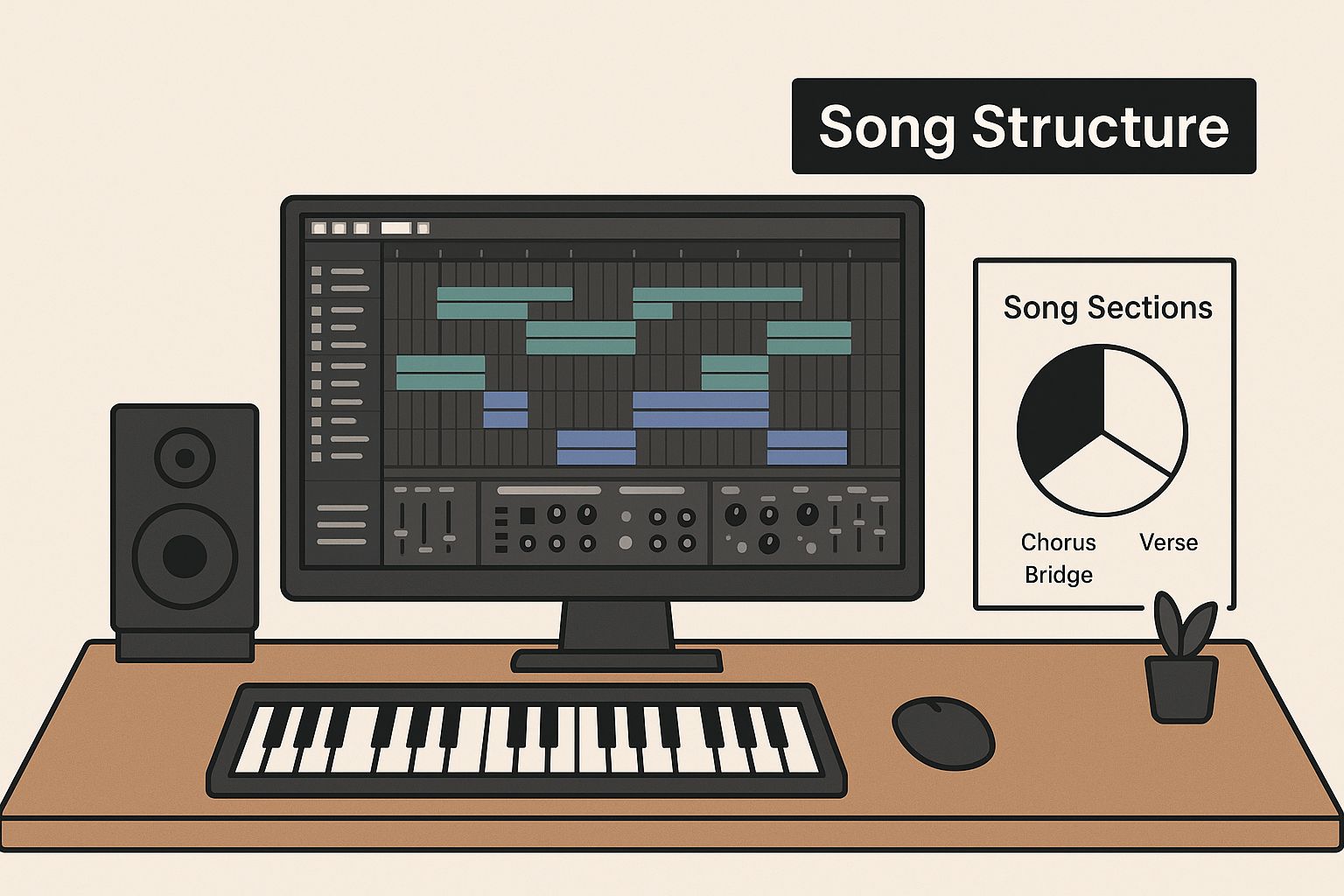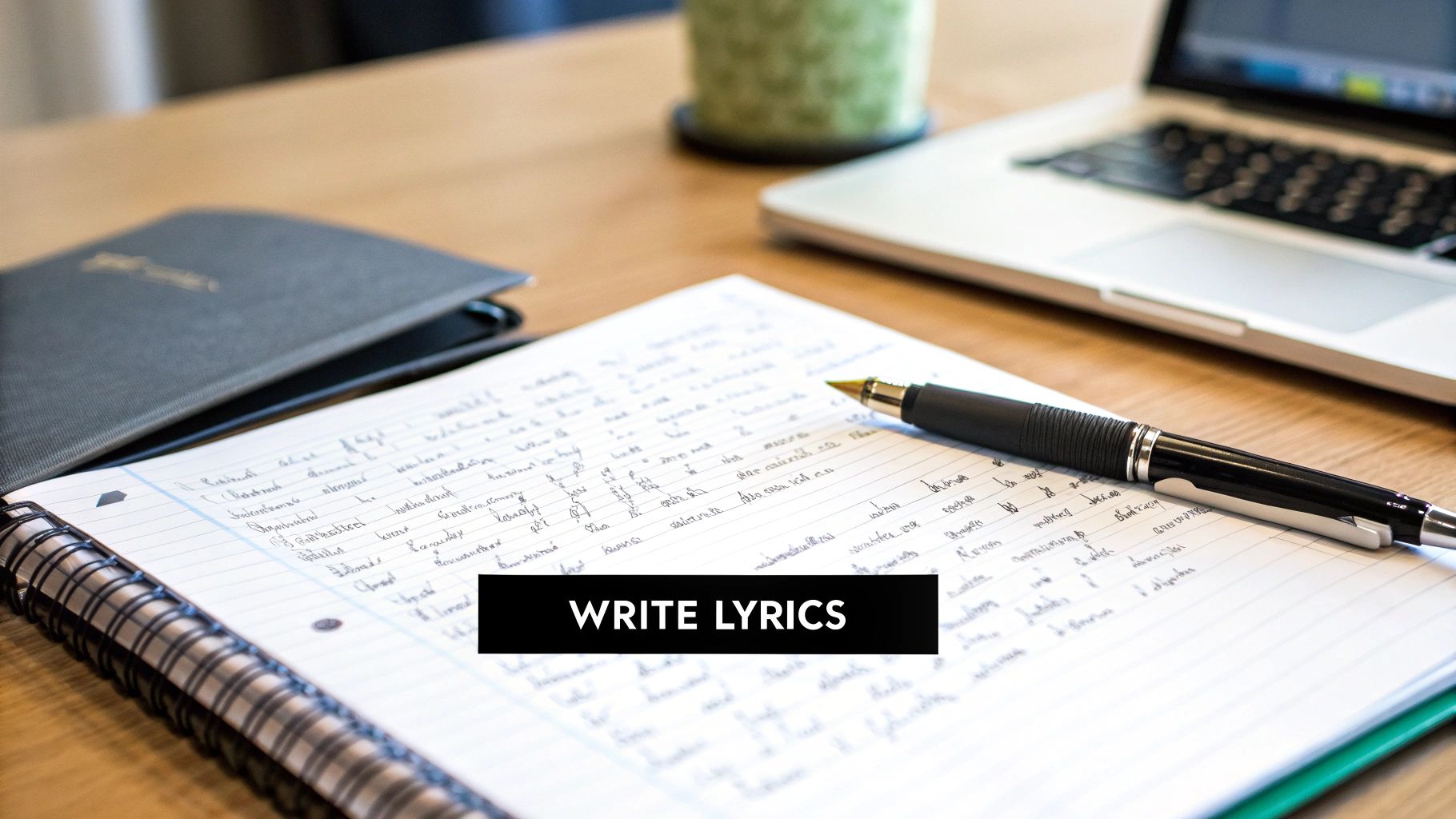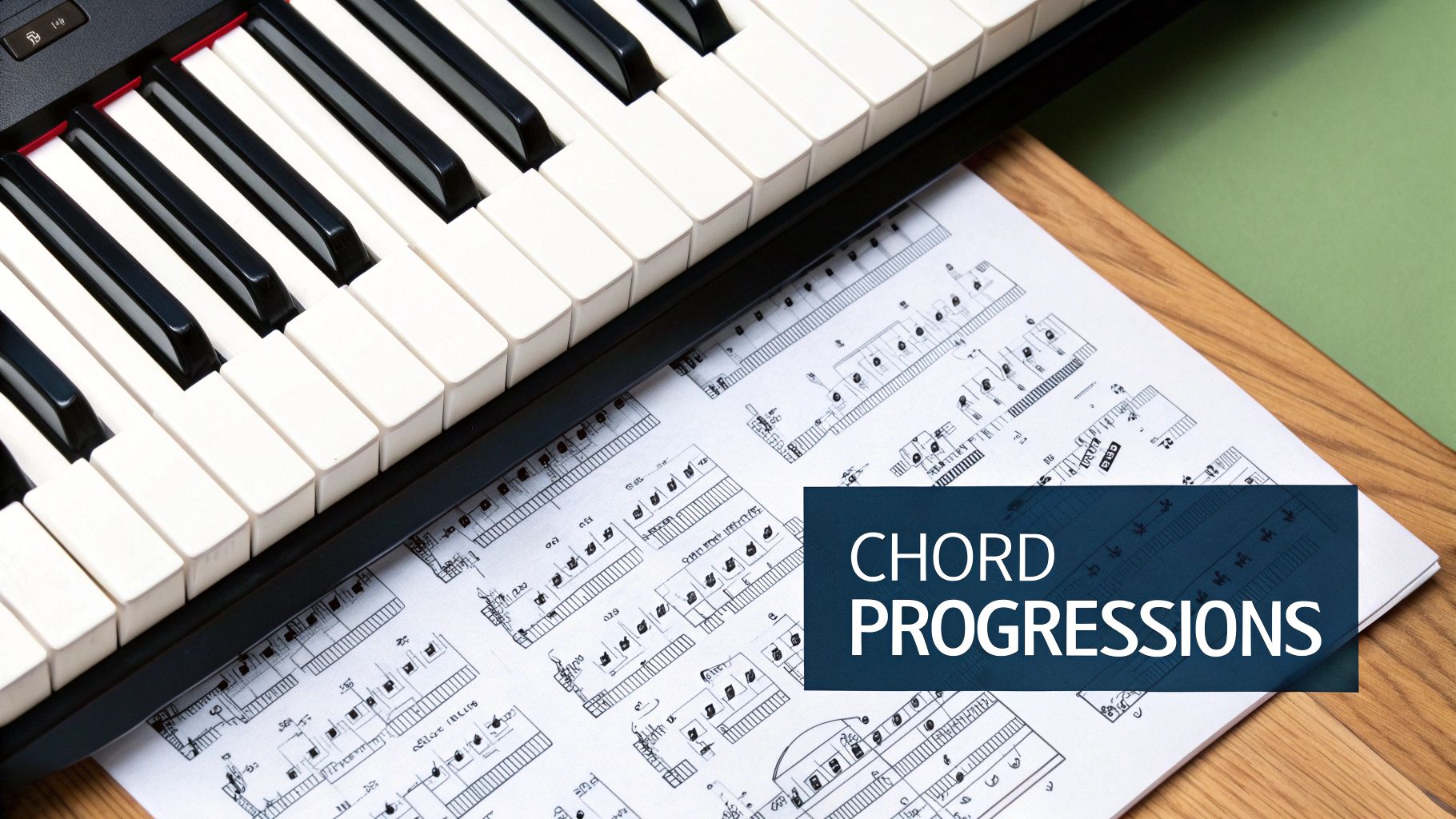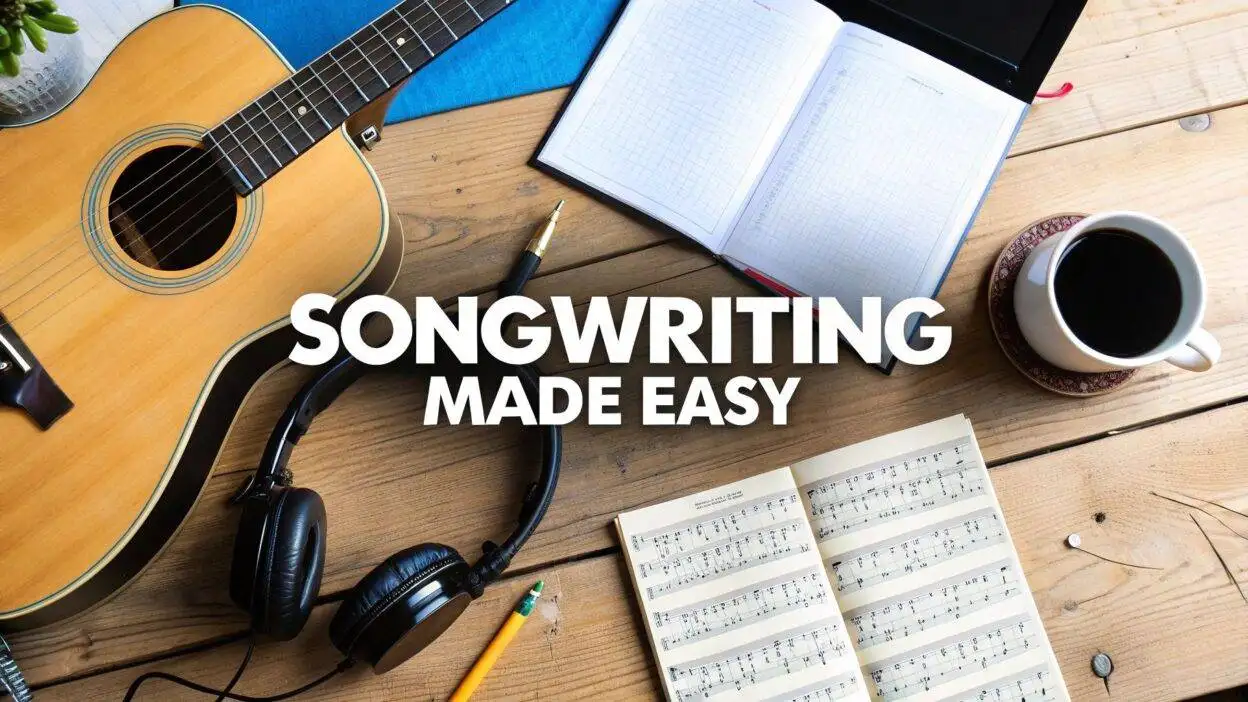Finding Your Musical Voice Without Overthinking It
Everyone has a unique musical voice, trust me. It might be hiding in plain sight – those little tunes you hum while doing the dishes, the rhythm you tap out on the steering wheel during your commute, that earworm that's been stuck in your head all week. Songwriting isn't about mastering complex music theory right off the bat. It's about noticing these spontaneous musical moments and letting them grow. Think of them as little seeds of musical potential just waiting to sprout.
I've talked to a lot of successful songwriters, and you know what? They didn't start out as virtuosos. They were music lovers who learned how to grab onto those fleeting musical ideas and develop them. Honing your "musical ear" doesn't mean you need years of formal training. Just actively listen to your favorite songs. Try humming along or picking out the melody on an instrument. Even something that simple can really boost your melodic awareness.
There are tons of free resources out there, too. Check out MusicTheory.net. They've got everything from basic note reading to more advanced harmony lessons. It's a fantastic resource for anyone starting out on their songwriting journey.
Figuring out your natural strengths is also super important. Are you a melody person? Do you love playing with words and crafting evocative lyrics? Maybe you're all about rhythm. Leaning into your inherent talents will build real confidence and help you create music that feels authentically you. And don't think you need a fancy studio setup to get started. A notebook, your voice, or a basic instrument is more than enough to capture those initial ideas.
The music industry, by the way, is booming. In 2024, recorded music revenues hit $29.6 billion globally – a 4.8% jump from the year before. Streaming services are a huge driver, along with independent music publishers, who now have a 26.3% share of the global market. Check out this report for more insights: Discover more insights about music industry growth. This shows there's plenty of room for new songwriters to find their audience. So, create a comfortable and inspiring songwriting space for yourself – somewhere you can be free from distractions and self-doubt. It's about inviting creativity in, not scaring it away. Even the simplest musical idea can become something amazing with a little time and care.
Understanding Song Structure Like Your Favorite Songs
Forget the dry music theory textbooks for a sec. Let's talk about the music you actually listen to. You know, the songs you belt out in the shower or have on repeat for weeks. If you listen closely, you'll notice patterns, familiar but still kinda magical structures that make them so catchy. Let’s break down these patterns and see how you can use them in your own songwriting journey.
Think about a legendary track like Queen’s "Bohemian Rhapsody." Epic, right? But also incredibly well-structured. The intro pulls you in, the ballad section tugs at your heartstrings, the guitar solo kicks you into high gear, and then the operatic section…pure drama. Finally, that hard rock outro leaves you breathless. That, my friend, is the power of a well-thought-out song structure.

That infographic up there shows a simple home studio setup with a song structure diagram. It emphasizes how important planning and visualizing your song’s sections are, even with minimal equipment. Structure is everything!
The Classic Verse-Chorus Structure
Most pop songs follow a basic verse-chorus-verse pattern. This is your foundation. The verse tells the story, setting the scene and developing the narrative. The chorus, on the other hand, delivers the main message—that earworm hook you just can’t shake. This repetition creates momentum and pulls the listener in. Think "Shake It Off" by Taylor Swift. The verses describe those annoying everyday situations, and the chorus offers the perfect antidote: shake it off! Simple, yet incredibly effective.

This screenshot from songwriting.net gives you a visual guide to different song structures. Notice how verses, choruses, and bridges fit together. The biggest takeaway? Song structure is flexible. There's no single "right" way to do it.
Adding the Bridge: A Change of Pace
The bridge is where you shake things up. It’s a detour from the verse-chorus loop, offering a fresh perspective both musically and lyrically. It provides contrast and builds up to that final chorus. One of my favorite examples is "Someone Like You" by Adele. That bridge builds so much emotional intensity before exploding back into the chorus. Chills, every time.
Beyond the Basics: Exploring Different Structures
Don't feel boxed in by the verse-chorus formula. Some songs have a pre-chorus, a build-up to create anticipation for the chorus. Others use a post-chorus, extending the impact of that main hook. Experiment! See what sounds best for your song.
Building Tension and Release
A key element in any good song is the interplay of tension and release. The verses might build tension, then the chorus releases it. This keeps listeners hooked and takes them on an emotional journey. It's like storytelling – peaks and valleys keep things interesting.
Practical Tips from the Pros
Many songwriters I know start with the hook—the catchiest part of the song. Then, they build the rest around that central idea. My advice? Don't be afraid to break the rules and play around with different structures. Songwriting, like any creative pursuit, is about finding your voice. And remember, even the simplest structure can be incredibly powerful when used effectively.
Let's take a look at some popular song structures:
To help visualize this, here's a handy table:
Popular Song Structures and Their Uses
Comparison of common song structures with examples and when to use each type
| Structure Type | Pattern | Best For | Famous Example |
|---|---|---|---|
| Verse-Chorus | V-C-V-C-B-C | Catchy, repetitive songs | "Shake It Off" – Taylor Swift |
| AABA (Ballad) | A-A-B-A | Storytelling, emotional songs | "Yesterday" – The Beatles |
| Verse-Chorus with Pre-Chorus | V-PC-C-V-PC-C-B-C | Building anticipation | "Teenage Dream" – Katy Perry |
This table outlines a few common structures, but there are so many variations out there. The key is to listen to your song and figure out what feels right. Each structure serves a purpose, influencing the overall mood and flow. Experiment and find what works for you!
Creating Melodies That Get Stuck in People's Heads
We've covered the bones of your song—the structure—so now let's talk about the meat: the melody. This is the part that really hooks people. What’s the secret sauce of a memorable melody? It’s not some mystical art, but a practical understanding of what our brains love.
The Psychology of Earworms
Think about tunes you can’t get out of your head. They usually play smart with repetition and variation. A catchy bit repeated gets lodged in your brain, but little changes each time around keep it fresh. Predictability mixed with surprise equals earworm. Also, most memorable melodies use scales and intervals that just sound right. Don't worry, songwriting doesn't have to be a theory-heavy slog. We'll stick to what actually works.
Working With Scales and Intervals
Scales are like musical alphabets, giving you notes that play nice together. The simple major scale is a perfect starting point. Intervals are the spaces between notes. Experiment with different intervals within a scale to find what clicks for you. Big jumps, small steps, high notes, low notes…play around!
This screenshot from Hooktheory.com visually breaks down melodic patterns and chord progressions in popular songs. See how some chord progressions tend to go hand-in-hand with certain melodies? This kind of analysis can be a goldmine of inspiration. For example, notice how certain chords naturally lead to others, building a sense of completion or anticipation.
Repetition and Variation: Your Melodic Secret Weapons
Found a melodic phrase you dig? Repeat it, but tweak it slightly. Maybe move it up a few notes, play with the rhythm, or add a flourish. This creates that sweet spot between familiar and new. It’s like telling a joke—the punchline lands better the second time if you deliver it with a twist.
Crafting Melodies That Feel "Right"
Some melodies just feel satisfying, while others fall flat. This often comes down to melodic resolution. Think of it like returning home after a trip. A common way to achieve this is by landing on the tonic (the “home base” note of your scale) at the end of a musical phrase. It’s like a sigh of relief for your ears. But sometimes, delaying that resolution creates delicious tension.
Overcoming Melody-Writing Roadblocks
Ever get stuck staring at your instrument, melody-less? It happens. Try humming or singing without worrying about hitting the “right” notes. Our voices can unlock ideas our fingers miss. Or, try listening to your favorite songs and tweaking their melodies to fit your lyrics. Inspiration is everywhere. I once got a melody from a leaky faucet!
Professional Songwriting Secrets for Melody
Many pros start with the melody before the lyrics. They might have a killer hook and build the song around it. It’s a solid approach. Don’t be afraid to experiment and break “rules.” There's no one way to write a melody. Trust your gut, try different things, and find what works for you. With a little practice and a lot of playing around, you'll be writing earworms in no time.
Writing Lyrics That Connect With Real People

This screenshot shows RhymeZone, a seriously helpful tool for finding rhymes. Type in a word, and boom! It generates a list of rhymes, along with their syllable counts and how often they're used. This is fantastic for anyone starting out with songwriting, because it takes the pressure off rhyming. You can focus on the feel of your words, not just the technical stuff.
Great lyrics are more than just clever rhymes; they create a connection between you and the listener. They take your personal moments and turn them into something universal. Think about your favorite songs—the lyrics probably resonate with you deeply, even if you haven’t had the exact same experiences.
Mining Your Life for Lyrical Gold
Your life is overflowing with lyrical inspiration. Everyday chats, overheard conversations, dreams, memories—they can all be transformed into song material. The trick is to avoid being too literal. Don’t just tell the story; capture the emotion behind it.
For example, instead of writing “My cat ran away,” try “Silence stretched where purrs used to be.” See how that evokes the feeling of loss without being overly descriptive?
Brainstorming and Developing Themes
Brainstorming is essential. Scribble down words, phrases, images, whatever pops into your head. Then look for patterns or recurring ideas. These themes will give your song depth and meaning. They're the thread that ties everything together. You might find some helpful tips in ChordX's guide on writing song lyrics.
Storytelling Through Verses and Choruses
Think of your verses as scenes in a movie. Each verse moves the story forward, adding detail or a new perspective. The chorus is your emotional anchor, the main message of your song.
Take Taylor Swift’s “Love Story” as an example. The verses tell the tale of a forbidden romance, while the chorus sums up the intense yearning to be together.
From Personal to Universal: Making Your Lyrics Relatable
The most effective lyrics feel both personal and relatable. This happens when you tap into universal emotions: love, loss, joy, fear, hope. Even if your experience is unique, the feelings it evokes are shared. That’s how you connect with your listeners.
Breaking Through Writer’s Block
Everyone gets stuck sometimes. If you hit a wall, try freewriting. Just write without stopping, even if it doesn’t make sense. This can unlock unexpected ideas.
Or try changing your surroundings. A walk in nature, a busy cafe, even a different room can shift your perspective. Switching instruments or trying a new songwriting technique can also help.
Rhymes That Flow, Not Force
Rhymes are powerful, but they shouldn’t feel forced. Avoid clichés and predictable rhymes. Near rhymes or slant rhymes can add a more subtle depth. Focus on the natural rhythm of your words and let the rhymes come organically.
Matching Words to Melody: A Symbiotic Relationship
Your lyrics and melody should work together. The rhythm of your words should complement the melody. High notes can highlight key words, while lower notes create intimacy. When words and melody are in sync, your song’s emotional impact is magnified.
The Art of Saying More With Less
Be concise. Every word should matter. Avoid unnecessary adjectives and adverbs. Sometimes, the most powerful lyrics are the simplest ones. Think about Leonard Cohen’s “Hallelujah.” Simple words, profound meaning. Aim for that lyrical economy.
Let’s talk rhyme schemes. Choosing the right rhyme scheme can drastically impact the feel of your song. Here's a quick breakdown:
Rhyme Scheme Patterns and Their Effects
| Rhyme Scheme | Pattern | Emotional Effect | Genre Usage |
|---|---|---|---|
| AABB | Line 1 rhymes with Line 2, Line 3 rhymes with Line 4 | Simple, direct, often used in children's songs or upbeat pop music. | Pop, Children's Music, Folk |
| ABAB | Line 1 rhymes with Line 3, Line 2 rhymes with Line 4 | Creates a sense of flow and connection between lines. | Ballads, Narrative Songs, Rock |
| AAAA | All lines rhyme | Can feel emphatic or even a bit overdone if not used carefully. | Hymns, Gospel, Sometimes in Pop |
| ABCB | Only Lines 2 and 4 rhyme | More conversational, less predictable. | Blues, Folk, Singer-Songwriter |
Each rhyme scheme has its own personality. Experiment to find what fits the mood and message of your song. Playing around with different patterns can lead to some cool discoveries.
Choosing Chords That Enhance Your Story

This screenshot from GuitarChords.com shows a simple chord chart for guitar. It’s a good reminder that even a handful of chords can unlock a universe of musical ideas. Songwriting is more accessible than you might think – you don't need to be a master of music theory to get started. Think of chords as the colors in your musical palette, painting the emotional landscape of your song. They set the mood, create the atmosphere, and support your melody and lyrics. This section will help you understand how to choose the right colors for your musical story.
The Power of Chord Progressions
A chord progression is just a series of chords played one after another. Some progressions are so common they're practically woven into our musical DNA. Take the I-V-vi-IV progression, for example (that's Roman numeral notation for chords, by the way). It's everywhere in pop music! Think "Let It Be" by The Beatles or "No Woman, No Cry" by Bob Marley – instant comfort and familiarity.
But chord progressions can also create tension, mystery, or a deep sense of sadness. The magic happens when you start experimenting and discover which progressions resonate with your song's message. That's where the real fun begins.
Matching Chords to Your Melody and Lyrics
Your chords, melody, and lyrics should all work together, telling the same story. A bright, joyful melody wouldn't feel quite right over a dark, minor chord progression, would it? Similarly, heartbroken lyrics wouldn't make much sense over a bouncy, major progression. Your chords provide the emotional backdrop, so choose them carefully.
Uplifting vs. Melancholy: Understanding Major and Minor
Generally speaking, major chords sound happy and uplifting. Minor chords, on the other hand, tend to create a more melancholic or introspective vibe. Switching between major and minor within the same song can create powerful emotional shifts, adding depth and interest. Even the simplest chord change can completely transform the feel of a section.
Experimenting with Chord Variations
Once you’ve got a handle on basic chords, start playing around with 7ths, suspensions, or other variations. These little additions can add color and complexity to your progressions. Adding a 7th to a major chord, for instance, can give it a jazzy or bluesy feel. It's a great way to make a familiar progression sound fresh and new. Another cool trick is changing the inversion of a chord (playing the notes in a different order). This can subtly shift the feel of the chord and how it flows into the next one. Don't hold back – experiment!
Simplicity vs. Complexity: Finding the Right Balance
Sometimes, the most effective chord progressions are the simplest ones. A well-placed two-chord vamp can be just as powerful as a complex, multi-chord masterpiece. It all depends on the song. Loads of hit songs use incredibly simple progressions, letting the melody and lyrics take center stage. But as you grow as a songwriter, don't be afraid to explore more complex harmonic territory. Finding the right balance is key.
Adapting Chords to Different Instruments
Chords sound different depending on the instrument you're playing. A C major on a piano has a completely different texture than a C major on a guitar. That’s part of what makes music so amazing! Explore how chords sound on your instruments. Whether it's a guitar, piano, ukulele, or even music apps on your phone, each instrument brings its own personality to the table.
This exploration of harmony adds depth and richness to your songwriting. It's interesting to note that the music industry itself is constantly adapting. In major markets like the USA and Canada, recorded music revenues saw a small increase of just 2.1% in 2024. This slower growth underscores the importance of songwriters adapting and using platforms like paid streaming services, which continue to be a major driver of revenue. Discover more insights about these trends. So, embrace the process, experiment, and find the emotional power in your chords. It’s a journey worth taking.
Navigating Today's Music Landscape as a New Songwriter
So, you’ve got the songwriting basics down—melodies, lyrics, chords—and now you’re ready to unleash your tunes on the world. But the music biz is a constantly shifting beast, and knowing the terrain is key for any songwriter trying to make a name for themselves.
The Streaming Revolution and Music Discovery
Think about how you discover new music. Chances are, it's through playlists on Spotify or Apple Music, algorithmic recommendations, or what your friends are sharing on social media. That’s how it works for most people now. This means you need to be smart about getting your music onto these platforms and in front of potential fans. Writing great songs is only half the battle; you’ve also got to understand how to navigate this new digital world.
Revenue Streams for Modern Songwriters
Landing a major record deal is still the dream for some, but these days there are so many other ways to make money from your songwriting. Sync licensing is a big one. This is where you get your music placed in films, TV shows, ads, even video games. It's a fantastic way to earn some cash and get your music heard. Online music libraries and royalty-free platforms offer other avenues, too. Diversifying your income streams is just good sense.
This screenshot is from the ASCAP website. They’re a performing rights organization – basically, they help songwriters collect royalties. ASCAP and similar organizations like BMI are crucial for songwriters to understand because they make sure you get paid when your music is played publicly. Protecting your intellectual property is essential in this business.
Building Relationships and Protecting Your Work
The music industry runs on relationships. Networking with other songwriters, producers, musicians, and industry folks can open doors you never imagined. Go to industry events, join online communities, and don’t be shy about reaching out to people whose work you admire. And while you’re building those connections, remember to protect your creative work. Register your songs with a copyright organization and get familiar with the basics of music publishing.
Realistic Expectations and Debunking Myths
There's this idea that music industry success happens overnight. The truth is, building a sustainable career as a songwriter takes time, dedication, and a lot of hard work. Don’t be discouraged if your first song doesn't hit the charts. Concentrate on honing your craft, learning the business side of things, and building real connections. Resources like ChordX’s guide on home music production can offer some really practical tips.
Building a Sustainable Songwriting Practice
Even if you only have a few minutes each day, creating a regular songwriting routine is important. Set achievable goals, keep track of your progress, and celebrate those small wins. Having a supportive community of other songwriters can also keep you motivated and give you valuable feedback. And most importantly, remember why you started writing songs in the first place. It's about expressing yourself, connecting with others, and creating something you’re proud of.
The global music industry has seen consistent growth over the last ten years, with 2024 marking its tenth consecutive year of rising revenues. But future growth projections aren't quite as rosy. Goldman Sachs revised its forecasts, predicting a market value of $31.4 billion in 2025. You can learn more about these trends and projections here. This just shows how important it is to adapt and understand the market.
Your songwriting journey is just beginning. Embrace the ups and downs, celebrate the successes, and keep learning. The music world is ready to hear your voice.
Your Songwriting Journey Starts Right Here
So, you've got the songwriting basics down – now it's time to get your hands dirty. This isn't some "songwriting for dummies" quick fix, but a real-world guide to building a songwriting practice that sticks, even with a busy life. We'll cover creating a routine, setting realistic goals, and tracking your progress to keep you inspired.
Building a Sustainable Songwriting Practice
Even just 15 minutes a day can work wonders. It's about consistency, not cramming. Some days you'll churn out a whole verse, others just a catchy melody fragment or a single lyric. It all adds up. Think of it like building muscle – regular short workouts are better than one massive session every few months. Keep a notebook and pen or a voice recorder app handy. You never know when inspiration will hit!
Setting Realistic Goals and Tracking Progress
Forget aiming for a number one hit right off the bat. Start small. Maybe your goal is one song a week, or even one a month. Whatever works for you. As you get more comfortable, you can ramp up your goals. Tracking your progress is huge for motivation. A simple spreadsheet, a journal, even sticky notes can do the trick. Seeing how far you’ve come is a real boost.
Finding Your Songwriting Tribe
Connecting with other songwriters can totally change the game. Online communities, local open mics, even starting a songwriting group with friends can be incredibly valuable. Sharing your work, getting feedback, and supporting each other makes the journey less intimidating and more fun. Personally, some of my best songs have come from brainstorming with other writers.
Dealing with Creative Blocks and Staying Inspired
Writer's block happens. Don't freak out. Try freewriting, switching instruments, or just stepping away for a bit. A nature walk or listening to music can reignite that creative spark. Remember that initial passion that drew you to music? Reconnecting with that can be powerful.
Celebrating the Small Victories
Finished a verse? Nailed a catchy chorus? Celebrate! Acknowledging those small wins keeps you going and makes the whole process more enjoyable. Your first song might not be perfect, and that's ok. It's a stepping stone to the next one, and the one after that. Every songwriter starts somewhere, and that somewhere is with your first song.
Ready to dive deeper? ChordX has tons of resources for songwriters of all levels, from beginner tips to advanced techniques. Check it out: ChordX – Your Ultimate Songwriting Resource



